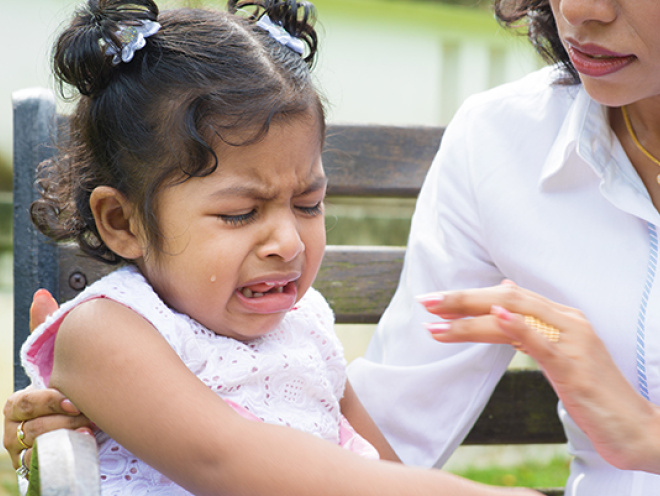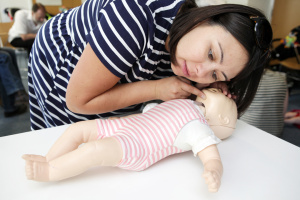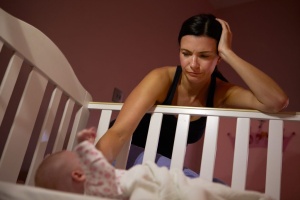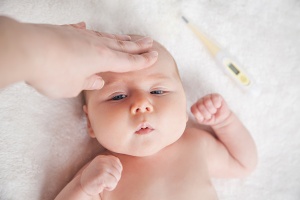Here we outline first aid treatment for burns and scalds when babies or young children are injured.
Babies and children have skin that is much more delicate than adults and far more easily damaged. As a result, if they experience a burn or scald, knowing how to treat them quickly and efficiently is crucial for a speedy recovery.
How to treat burns and scalds
If your child experiences a burn or scald, think: cool, cover and call.
1. Cool the burn or scald under cold running water for at least 20 minutes and remove all clothing (including nappies) and jewellery (unless it is melted and firmly stuck to the wound).
2. Cover with something clean and non-fluffy. You could use loosely applied cling film or a clean plastic bag, for example (but never over the face).
3. Call 999 or seek medical advice.
Tips to avoid burn and scalds around the home
The most common cause of scald injuries among young children are hot drinks. A hot drink which has been left to cool for 15 minutes could still scald a baby. To reduce the risk:
- Avoid holding your baby and a hot drink at the same time. A wriggling baby may cause you to spill your drink on them and you.
- Try not to leave hot drinks within easy reach. Babies are likely to grab at cups or mugs and spill the contents over themselves.
Here are other potential hazards to be aware of around the home that could cause burns and scalds:
In the kitchen
Hot kettles, chip pans, saucepans, oven rings, irons and even oven doors could all potentially burn or scald your child. One tip is to turn saucepan handles inward on the hob when you’re cooking; they’ll be harder to knock over and have their contents splash out.
Also, try and cook on the back hob to make pans harder for a child to reach.
In bedrooms
Hair straighteners and curling tongs can be incredibly hot to touch without looking like they are. Remember to unplug them after use and put them away out of your child’s reach. If you have a heat resistant protective pouch for your tongs or straighteners, use that.
In the bathroom
Many scald accidents happen when a child gets into the bath before the temperature has been tested. To help avoid scalding, run the cold water first in the bath before adding hot water. You might also run cold water again at the end to avoid any contact scalding from the hopt tap.
Always check the water before putting your child in. Read our article on ‘Bathing your baby’ for more bathing tips.
In the garden
If you’re having a BBQ, bonfire or fireworks night, keep children at a safe distance from the fire, grill or fireworks. Explain the dangers of getting too close if they’re old enough and keep an eye on crawling babies or toddlers.
Never use any accelerants near or on fires.
Frequently asked questions about burns and scalds
What’s the difference between a burn and a scald?
Burns are caused by contact with hot objects, such as flames, or by friction, such as rope burns. Scalds are caused by steam or hot liquids, such as tea or oil. Treat both burns and scalds using the ‘cool, call and cover’ steps described above.
Why is cooling important?
It’s important to cool burns and scalds because it helps ease any pain the baby or child will be feeling, reduces the severity of the burn injury, improves wound healing and reduces the risk of long-term scarring. Remember though that a child should be kept warm while cooling the affected area.
The British Burns Association also advises that the cooling of burns is still effective within three hours of initial injury.
What should I use to cool a burn if I don’t have any cold running water?
You can use a cold liquid like milk or juice to cool the burn until you get to cold running water.
Burn specialists also recommend using a towel or cloth soaked with some water, which should be changed every five minutes to ensure ongoing cooling. Bottled water is often available when there is no access to running tap water.
If my child or baby is wearing clothing on the area of the body that has been burned, should I remove the clothes?
If the clothing is stuck to the burn area you should leave the clothing in place. However, if the clothing is not stuck to the burn, and you can remove it, you should do so.
Can I use a shower to cool the affected area?
A shower is a good way of flooding the burn with cool water to help the cooling. Cooling should focus on the site of the burn itself rather than the whole limb or body though. Putting the child’s whole body under a cold shower could induce hypothermia and is not advised.
Should I place my child or baby in a cold bath?
No, this may also cause hypothermia. Cooling should only focus on the site of the burn - not the patient.
Should I use ice to cool the burn?
No. Ice may further damage the skin and lead to hypothermia and long-term scarring.
If it’s a severe burn, should I cool the burn for 10 minutes and then go to hospital, or should I go straight to hospital?
If it’s a severe burn, cool it under running water immediately. Call 999 while you’re cooling the burn and continue to do so until the ambulance arrives.
If the burn is still painful after I have cooled it for 10 minutes and covered it, what should I do?
The chances are the burn will still be painful. Don’t forget to give painkillers, such as a paracetemol-based syrup, and reassure your child to help them remain calm. Always seek medical advice for a baby or child who has been burned. All burns or scald injured with babies and children need medical attention, even small ones, because their skin is so delicate and still growing.
If the burn is still painful after 10 minutes, you could continue to cool it with water until help arrives or the painkillers start to work. After cooling, covering the burn wound with loose cling film will also offer pain relief.
I’ve heard I should put a plaster over the burn to make sure it doesn’t get infected. Is that right?
Don’t use any adhesive bandages to cover a burn. They will stick to the skin and may cause further damage. After the burn has been cooled, covering it loosely with cling film or a clean plastic bag will help prevent infection and won’t stick to the burn.
Should I put butter, ointment or a cream on a burn?
No, these will not help to cool the area. All oils retain heat, which is the opposite of what you’re trying to do. Also, if you put anything on top of a burn and it needs to be removed later in hospital, it may cause further pain, distress and damage.
I was told that rubbing toothpaste into a burn will soothe it - is this right?
There is no clinical evidence to suggest putting toothpaste on a burn is beneficial. People tend to apply toothpaste because it often contains ingredients like menthol or eucalyptus, which give some superficial relief to the surface of the burn area, but the importance of cooling a burn is to reach deep down under the skin where it’s damaged.
Further information
Our support line offers practical and emotional support with feeding your baby and general enquiries for parents, members and volunteers: 0300 330 0700.
NCT and Mini First Aid run First Aid courses for parents with babies and children on life-saving topics, such as CPR, stopping bleeding and what to do if your child is choking. Find your nearest course.
The Children’s Burns Trust is a national charity dedicated to providing rehabilitation support for burned and scald injured children and their families as well as prevention and awareness campaigns.
The Fire Service provides safety advice on fire safety in and outside the home.
The Royal Society for the Prevention of Accidents has information on firework safety.








